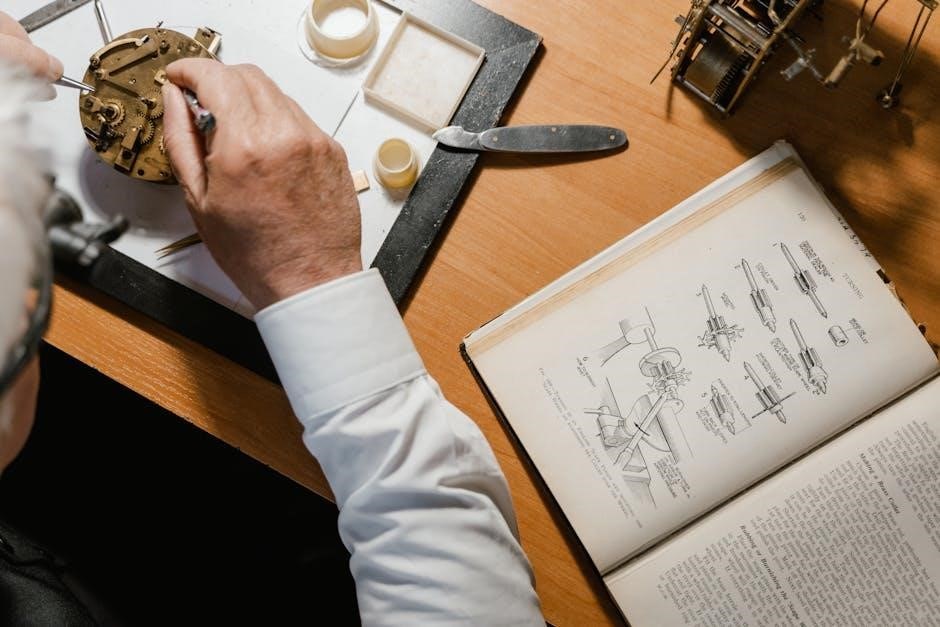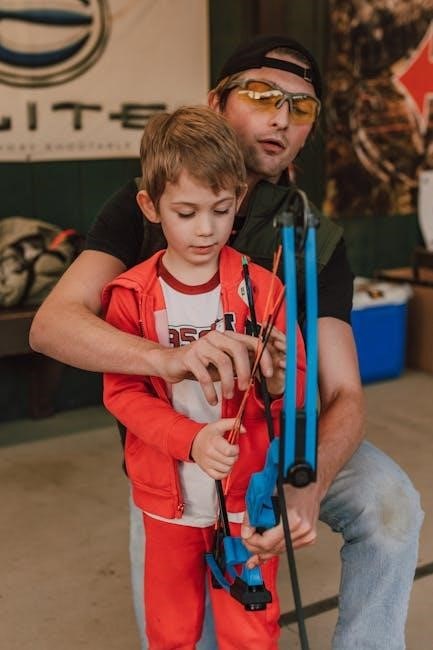Safety Precautions
Always disconnect power before maintenance or installation. Ensure the fan is securely mounted to avoid structural damage. Wear gloves when handling heavy components like blades or motors. Avoid overreaching while installing to prevent falls. Never touch electrical wires without proper insulation or protective gear. Keep children away during installation or repairs. Follow all local electrical codes and manufacturer guidelines for safe operation.
1.1. General Safety Guidelines
- Always disconnect the power supply before performing any maintenance or installation to ensure safety.
- Ensure the fan is securely mounted to the ceiling to prevent structural damage or accidents.
- Wear protective gloves and eyewear when handling sharp or heavy components like blades or motors.
- Avoid overreaching or standing on unstable surfaces while installing or servicing the fan.
- Keep loose clothing and long hair tied back to prevent entanglement with moving parts.
- Never operate the fan near water or in humid environments to avoid electrical hazards.
- Keep children and pets away from the fan during installation or maintenance.
- Follow all manufacturer guidelines and local safety codes for proper installation and operation.
1.2. Electrical Safety Tips
- Always turn off the power to the fan at the circuit breaker before performing any electrical work.
- Verify that the fan’s voltage rating matches your home’s electrical system to prevent damage or hazards.
- Use properly rated wires and connectors to avoid overheating or electrical fires.
- Avoid overloading circuits with additional devices that could strain the electrical system.
- Never touch electrical wires with bare hands or without proper insulation to prevent shock.
- Ensure all connections are secure and tight to avoid loose wires that could cause sparks or fires.
- If unsure about any electrical aspect, consult a licensed electrician for assistance.
1.3. Weight and Handling Precautions
- Hunter ceiling fans can weigh up to 50 lbs, so handle with care to avoid injury or damage.
- Always lift safely, bending at the knees and using proper lifting techniques.
- Use a sturdy ladder or step stool to reach the ceiling securely.
- Have someone assist you when lifting or holding the fan during installation.
- Ensure the fan is properly secured to the ceiling mount to prevent imbalance or falling.
- Verify that the ceiling can support the fan’s weight to avoid structural damage.

Understanding Your Hunter Ceiling Fan
Learn about your Hunter ceiling fan’s design, features, and components. This section helps you identify key parts and understand how your fan operates efficiently for optimal performance.
2.1. Key Components of the Fan
Your Hunter ceiling fan consists of essential components like the motor housing, fan blades, mounting hardware, and control systems. The motor powers the fan, while blades distribute air evenly. Mounting hardware ensures secure installation, and control systems, such as remotes or switches, regulate operation. Additional features may include light kits or smart technology. Understanding these components helps you operate, maintain, and troubleshoot your fan effectively. Each part is designed for durability and energy efficiency, ensuring optimal performance and longevity of your ceiling fan.
2.2. Model Identification and Serial Number
To identify your Hunter ceiling fan, locate the model number, typically a 5-digit sequence (e.g., 22345A), found on the installation manual, parts guide, or the fan itself. This number is essential for ordering replacement parts or accessing specific instructions. The serial number, usually nearby, helps track your fan’s production details. Accurate identification ensures you receive the correct manual, parts, and support. Refer to the owner’s manual or Hunter’s website for guidance on locating these identifiers, which are crucial for warranty claims and technical assistance.
2.3. Fan Types and Special Features
Hunter ceiling fans are available in various styles, including modern, traditional, and vintage-inspired designs, each tailored to complement different home decors. Special features may include energy-efficient motors, silent operation, and smart home compatibility for advanced control. Some models offer dual fan and light controls, enhancing functionality. Indoor fans are engineered for optimal airflow and durability, while certain series boast adjustable speed settings and quiet performance, ensuring a blend of style and functionality for any room, making them versatile and adaptable to various settings.

Installation Instructions
Locate ceiling joists for secure mounting. Drill holes for screws and connect wires carefully. Ensure proper electrical connections and test the fan before final assembly. Follow manual guidelines precisely for safe and efficient installation.
3.1. Pre-Installation Checks
Before installation, ensure the power is turned off at the circuit breaker. Verify the ceiling can support the fan’s weight, typically up to 50 lbs. Check for sturdy ceiling joists or supports. Inspect electrical wires for proper connections and ensure they meet local codes. Confirm the fan’s dimensions fit the space. Gather all tools and accessories, including screws and mounting hardware. Review the manual to ensure all parts are included and undamaged. Double-check the model number matches the instructions for compatibility.
3.2. Assembling the Fan
Begin by carefully unpacking all components and verifying no parts are damaged. Attach the fan blades to the motor housing using the provided screws. Ensure blades are evenly spaced and securely fastened. If your model includes a light kit, install it according to the manual, connecting the wires properly. Mount the remote receiver (if applicable) inside the housing. Tighten all connections firmly to prevent vibration. Handle the glass or plastic components with care to avoid breakage. Double-check all fasteners before proceeding to mounting the fan on the ceiling.
3.3. Mounting the Fan on the Ceiling
Locate the ceiling joist or suitable support to ensure a secure installation. Drill pilot holes and install the provided screws or anchors. Carefully lift the fan and attach it to the mounting bracket, ensuring all screws are tightened firmly. For heavier models (up to 50 lbs), verify the weight limit of the bracket. Connect the electrical wires according to the manual, ensuring no loose connections. Double-check the fan’s stability before releasing it. Once mounted, test the fan at a low speed to ensure proper balance and operation.
3.4. Wiring and Electrical Connections
Before wiring, ensure the power to the circuit is turned off. Use a voltage tester to confirm no electricity is present. Match the black (hot), white (neutral), and copper (ground) wires to the corresponding terminals on the fan and ceiling. Secure all connections tightly to avoid loose wires. If your fan includes a light kit, connect the additional wires as specified in the manual. Double-check all connections for accuracy. If unsure, consult a licensed electrician to ensure compliance with local electrical codes and safe installation.
3.5. Installing the Light Kit (if applicable)
Disconnect power to the fan before starting. Attach the light kit to the fan housing using the provided screws or clips. Align the kit securely and tighten firmly. Connect the light wires to the fan’s wiring harness, matching colors as specified in the manual. Install the bulbs with the correct wattage rating. Reconnect power and test the light operation. Ensure all connections are secure to avoid loose wires. Refer to the manual for specific instructions, as models may vary. If unsure, consult a licensed electrician for assistance.
3.6. Final Assembly and Testing
After completing the installation, reattach any decorative covers or trim. Turn the power back on at the circuit breaker. Test the fan’s operation by using the remote or wall control, ensuring all speed settings and light functions work properly. Check for any wobbling or noise during operation. Tighten any loose screws if necessary. Verify that the light kit (if installed) is functioning correctly and replaced any protective coverings. Ensure all components are securely fastened for safe and efficient operation. If issues arise, consult the troubleshooting section or contact support.

Operating Your Hunter Ceiling Fan
Use the remote or wall control to adjust speed and direction. Switch between summer and winter settings for optimal airflow. Refer to the manual for troubleshooting common issues.
4.1. Basic Operation and Speed Settings
To operate your Hunter ceiling fan, turn it on using the wall control or remote. Adjust the speed settings to low, medium, or high based on your preference. For reverse operation, use the remote or switch located on the fan. Ensure the fan is turned off before cleaning or performing maintenance. Always refer to the manual for specific instructions on speed settings and direction adjustments; Proper operation ensures energy efficiency and optimal airflow in your space.
4.2. Using the Remote Control (if applicable)
For models equipped with a remote, press the power button to turn the fan on or off. Use the speed buttons to adjust between low, medium, and high settings. The reverse button toggles the fan direction for seasonal use. Ensure the remote is synced with the fan by following the pairing instructions in the manual. If issues arise, reset the remote by turning off the power, waiting 15 seconds, and turning it back on. Always refer to the manual for specific remote functions and troubleshooting tips.
4.3. Adjusting the Fan Direction (Summer/Winter Settings)
To optimize airflow year-round, adjust the fan direction using the reverse switch, typically located on the motor housing or remote. For summer, set the fan to counterclockwise to circulate cool air downward. In winter, switch to clockwise to redistribute warm air evenly. Ensure the fan is turned off before changing direction. This feature enhances energy efficiency and comfort in both seasons. Always refer to the manual for specific switch locations and operation guidance for your model.
4.4. Troubleshooting Common Issues
If the fan doesn’t turn on, check the power source and circuit breaker. Ensure the remote batteries are fresh and properly installed. For blades not spinning, verify the direction switch is set correctly and speed settings are functional. If the fan hums but doesn’t move, inspect for blockages or loose connections. For remote control issues, re-sync the remote with the fan by turning the power off and on. Refer to the manual for specific troubleshooting steps tailored to your model. Always ensure safety before attempting any repairs.

Maintenance and Care
Regularly clean fan blades with a soft cloth to prevent dust buildup. Inspect and tighten loose screws. Lubricate moving parts annually for smooth operation. Replace light bulbs as needed to maintain illumination. Always turn off power before performing maintenance to ensure safety.
5.1. Cleaning the Fan Blades and Housing
Regularly clean fan blades and housing to ensure optimal performance and aesthetics. Use a soft, dry cloth to wipe down blades and remove dust buildup. For tougher spots, dampen the cloth slightly but avoid using harsh chemicals or abrasive materials. Turn off the power before cleaning to prevent accidental start-up. Avoid spraying cleaning products directly on the fan. Instead, apply the cleaner to the cloth first. Pay special attention to crevices and corners where dust tends to accumulate. Cleaning maintains airflow efficiency and keeps your fan running quietly and smoothly.
5.2. Balancing the Fan Blades
To balance your Hunter ceiling fan blades, start by ensuring all blades are evenly aligned and securely attached. Use a balancing kit, which may include weights or clips, to adjust any imbalanced blades. Turn off the power before beginning. Gently straighten any bent blades or replace them if necessary. Attach weights to the lighter blades to counterbalance heavier ones. Test the fan after each adjustment to check for wobbling. Repeat until the fan operates smoothly and quietly. Proper balancing prevents noise and ensures efficient operation.
5.3. Lubricating Moving Parts
Regular lubrication of moving parts ensures smooth operation and reduces noise. Turn off the power before lubricating. Use a high-quality, silicone-based lubricant on the motor shaft and bearing assemblies. Avoid over-lubrication, as excess grease can attract dust. Apply a few drops to each moving part, then gently rotate the fan blades to distribute the lubricant evenly. Test the fan after lubrication to ensure quiet and efficient operation. Proper lubrication extends the lifespan of your Hunter ceiling fan and maintains optimal performance.
5.4. Replacing Light Bulbs
To replace light bulbs, first turn off the power at the electrical source and allow the bulbs to cool. Remove the glass cover or shade by gently lifting or unscrewing it, depending on your fan model. Grasp the bulb firmly and twist it counterclockwise to remove it. Insert the new bulb, ensuring it is compatible with your fan’s wattage and type. Replace the glass cover securely. Dispose of the old bulb safely. If unsure, consult your Hunter ceiling fan manual for specific bulb recommendations to ensure optimal performance and warranty compliance. Always test the light after replacement.

Troubleshooting
Check if power is connected. Ensure remote batteries are functional. Verify wiring connections are secure. Reprogram the remote if necessary. Consult the manual for specific solutions.
6.1. Fan Not Turning On
First, ensure the power is turned off at the circuit breaker. Check if the remote control batteries are functioning properly. Verify all wiring connections are secure and correctly matched. If using a wall switch, confirm it is in the “on” position. Ensure the fan’s power source is reliably connected. If issues persist, consult the manual for specific troubleshooting steps or contact Hunter’s customer support for assistance. Always prioritize safety when addressing electrical issues.
6.2. Fan Blades Not Spinning
First, ensure the fan is receiving power by checking the circuit breaker and wall switch. Verify the remote control has functional batteries and is properly synced; If the fan Blades are new, check if they are securely attached but not overly tightened. Inspect for any blockages or obstructions. If issues persist, consult the manual for specific troubleshooting or contact Hunter’s support. Always ensure safety by disconnecting power before performing any repairs or adjustments.
6.3. Humming or Noisy Operation
If your Hunter ceiling fan is producing unusual humming or noise, check for loose screws or misaligned blades. Ensure all mounting hardware is securely tightened. Inspect the fan motor for worn bearings or debris accumulation. Lubricate moving parts if necessary. Verify that the fan is properly balanced and aligned. If the issue persists, consult the manual for specific troubleshooting steps or contact Hunter’s customer support for assistance. Always ensure power is disconnected before performing any inspections or repairs.
6.4. Remote Control Issues
If the remote control isn’t functioning properly, ensure batteries are fresh and correctly installed. Check for RF interference from nearby devices. Reprogram the remote by turning off the fan circuit for 15 seconds, then back on. Use the dip switches on the remote and receiver to reset the connection. If issues persist, consult the user manual for specific instructions or contact Hunter’s customer support. Always verify the remote is compatible with your fan model and follow manufacturer guidelines for troubleshooting.

Repair and Replacement Parts
Identify replacement parts using Hunter’s parts guide. Order online or through authorized dealers. Ensure compatibility with your model. Contact customer support for assistance with purchases or installations.
7.1. Identifying Replacement Parts
To identify replacement parts for your Hunter ceiling fan, refer to the detailed parts guide provided in the owner’s manual or available online. Each part is listed with corresponding model numbers and descriptions. Use the model number found on the fan’s packaging or the base to ensure compatibility. Common replacement parts include fan blades, light kits, remote controls, and motor housing components. Visit Hunter’s official website or contact customer support for assistance in locating specific parts.
7.2. Ordering Replacement Parts Online
Visit Hunter’s official website to order genuine replacement parts securely. Use the model number from your fan’s manual or base to ensure compatibility. Browse the parts catalog, select your items, and proceed to checkout. Payment options include major credit cards and PayPal. Allow 3-7 business days for standard shipping. For expedited delivery, choose express shipping at checkout. If unsure about compatibility, contact Hunter’s customer support for assistance before placing your order. Keep your order confirmation for tracking and potential returns.
7.3. Installing Replacement Parts
Before installing replacement parts, ensure the fan is turned off and the power supply is disconnected. Refer to your instruction manual for specific guidance. Start by accessing the fan’s components, which may require removing light kits or blade assemblies. Disconnect wiring carefully to avoid damage. Remove the faulty part using the provided screws or clips. Install the new part securely, following the reverse process. Reassemble all components and restore power. Test the fan to ensure proper operation. If unsure, consult a licensed electrician for assistance.

Technical Specifications
Check the fan’s dimensions, weight, and electrical requirements. Ensure compatibility with your ceiling type and electrical system. Verify airflow and energy efficiency ratings for optimal performance.
8.1. Fan Dimensions and Weight
Verify the fan’s dimensions to ensure proper fit in your space. Typical blade spans range from 42 to 60 inches. Check the ceiling clearance requirements, usually 7-10 feet for optimal airflow. The fan’s weight, often between 30-50 pounds, is crucial for secure mounting. Ensure your ceiling can support the weight to avoid structural damage. Measure the fan’s height, including the downrod, to maintain adequate clearance from floors and furniture. Refer to the manual for exact measurements to ensure safe and proper installation.
8;2. Electrical Requirements
Your Hunter ceiling fan requires a dedicated 15- or 20-amp electrical circuit to ensure safe and proper operation. Use 14/3 wire for fans with light kits or 14/2 wire for fans without lights. Install a dual fan/light switch for independent control of the fan and light. Ensure the circuit is rated for the fan’s power consumption, typically 120 volts at 60 Hz. Some models may require specific wiring configurations, especially if a remote control is included. Always verify the voltage and amperage ratings in the manual to match your home’s electrical system.
8.3. Airflow and Energy Efficiency
Hunter ceiling fans are designed to provide optimal airflow while maintaining energy efficiency. Most models feature high-quality motors that deliver superior air circulation with minimal power consumption. Energy-efficient designs, such as DC motor technology, reduce energy usage without compromising performance. LED light kits further enhance energy savings, using significantly less power than traditional bulbs. By circulating air effectively, these fans help reduce heating and cooling costs, making them an eco-friendly choice for year-round comfort. Always refer to the manual for specific energy ratings and airflow measurements in CFM (cubic feet per minute).

Hunter Fan Warranty Information
Hunter ceiling fans come with a limited warranty covering defects in materials and workmanship. The motor is typically covered for life, while parts and labor are covered for one year from purchase. Registration is required for warranty activation. For full details and filing claims, refer to the manual or visit Hunter’s official website.
9.1. Warranty Coverage and Duration
Hunter ceiling fans are backed by a comprehensive warranty program. The motor is covered for its entire lifespan, ensuring long-term reliability. Other components, including parts and labor, are typically covered for one year from the date of purchase. This coverage ensures that any manufacturing defects or issues are addressed promptly. It’s important to note that the warranty is non-transferable and applies only to the original purchaser. Proper registration and adherence to installation guidelines are essential to maintain warranty validity.
9.2. Registering Your Fan
Registering your Hunter ceiling fan is a simple process that ensures you receive the full benefits of your warranty and customer support. To register, visit the official Hunter Fan website and navigate to the registration page. You will need your fan’s model number, serial number, and purchase date. Fill out the required fields with your contact information to complete the process. Registration helps Hunter track your warranty and provides access to exclusive updates and support services. Keep your registration confirmation for future reference.
9.3. Filing a Warranty Claim
To file a warranty claim, contact Hunter Fan customer support with your fan’s model and serial number, along with proof of purchase. Provide a detailed description of the issue. If required, return the defective part using a prepaid shipping label provided by Hunter. Once the claim is reviewed and approved, Hunter will repair or replace the defective part according to the warranty terms. Ensure all submissions comply with Hunter’s return and replacement policies for a smooth process.

Hunter Fan Support and Resources
Hunter Fan offers comprehensive support through their website, including online manuals, troubleshooting guides, and FAQs. Contact customer service via phone, email, or live chat for assistance.
10.1. Contacting Customer Support
For assistance with your Hunter ceiling fan, contact customer support via phone at 1.888.227.2178 (Mon-Fri, 8AM-5PM CST). Email inquiries are also welcomed. Visit the Hunter Fan support website for live chat options, troubleshooting guides, and FAQs. Representatives are trained to help with installation, repair, or replacement parts. Ensure to have your fan’s model number and serial number ready for efficient service. The support team is available to address any concerns and provide solutions to ensure optimal performance of your ceiling fan.
10.2. Online Manuals and Guides
Visit the Hunter Fan official website to access online manuals, guides, and resources for your ceiling fan. Download PDF versions of owner’s manuals, installation guides, and parts catalogs specific to your fan model. Use the search function to find manuals by model number or product name. Troubleshooting guides and FAQs are also available to help resolve common issues. Additionally, the website offers detailed instructions for assembling, installing, and maintaining your fan. These resources ensure you have comprehensive support for optimal performance and longevity of your Hunter ceiling fan.
10.3. Frequently Asked Questions (FAQs)
Check the FAQs section on the Hunter Fan website for answers to common questions about installation, operation, and troubleshooting. Learn how to resolve issues like a fan not turning on, noisy operation, or wobbling blades. Find tips on how to properly balance fan blades, reset remote controls, and replace light bulbs. Discover how to identify your fan model and locate replacement parts. The FAQs also cover topics like energy efficiency, airflow settings, and warranty information. This resource helps you quickly address concerns and enjoy optimal performance from your Hunter ceiling fan.